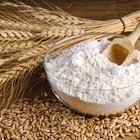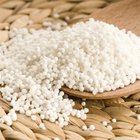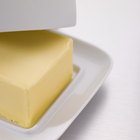
Airy, light sponge cakes are a product of the 20th century. Historically, cakes were dense, but the development of a low-protein, bleached flour led to lighter cakes. Using the right type of flour when making a sponge cake greatly affects the final outcome.
What is Bread Flour?
Bread flour comes from a type of wheat that contains a high amount of protein. The flour typically has a protein content between 12 and 13 percent while all-purpose flour has a protein content between 7.5 and 12 percent, depending on the brand and where you purchase the flour. The higher protein content means that more gluten develops when you mix bread flour into a dough. The finished product, usually a type of bread, has a chewy texture.
What is Cake Flour?
Cake flour has a very low protein content, usually between seven and eight percent. Cake flour is also usually bleached with chlorine, though you can buy unbleached versions. The presence of chlorine affects the starch in batter. Thanks to the bleach, the starch is able to bind with the fat in a cake recipe more effectively. The chlorine also helps the cake rise, since the starch in the flour absorbs water and sugar better. The result is a light texture, even when there is a higher ratio of sugar to flour in the recipe. In a traditional sponge cake, the ratio of sugar to flour is 225 to 100.
Flour in Cake
Cake flour is the preferred flour for sponge cake. Bread flour is not a suitable substitute for the cake flour since the two types of flour are so profoundly different. The high gluten content in bread flour will give you a cake that is tough rather than its optimal light and crumbly texture.
Substituting With All-Purpose Flour
If you are attempting to make a sponge cake and find that you don't have any cake flour, you still have some options. If a recipe calls for cake flour, use one tablespoon less of all-purpose flour per cup called for. Another way to replicate the action of bleached cake flour using all-purpose is place up to four tablespoons of cornstarch in a one-cup measuring cup, then fill the rest of the way with all-purpose flour. The starch reduces the protein content and makes the mix finer.
Related Articles

What Kind of Flour to Use for Cupcakes?
Does Cake Flour Contain Baking Soda & ...
What Is the Difference Between Cake ...
What Kind of Flour Do You Use for a ...

Do You Still Need Baking Powder & Salt ...

Differences Between Bleached Flour & ...
Can You Substitute Whole-Wheat Pastry ...
Is Unbleached Flour the Same as ...
Should Cake Flour Be Sifted Before ...

Can I Substitute Bleached for ...

Can You Substitute Whole Wheat Pastry ...

Can You Make Dumplings With Corn Starch?

What Is the Nutritional Value of ...
Flour Substitute for Muffins

How to Replace Flour With Oat Flour
What Can I Use As a Sugar Substitute ...

Butter Substitute for Molten Lava Cake

Do Eggs Make Baked Goods Rise?

How Do Different Types of Flour Affect ...

Does Unbleached Bread Flour Make ...
References
- "On Food and Cooking"; Harold McGee
- Fine Cooking: Choosing Flour for Baking
- King Arthur Flour: Cake Primer
- Bon Appetit: Chocolate Sponge Cake
Writer Bio
Based in Pennsylvania, Emily Weller has been writing professionally since 2007, when she began writing theater reviews Off-Off Broadway productions. Since then, she has written for TheNest, ModernMom and Rhode Island Home and Design magazine, among others. Weller attended CUNY/Brooklyn college and Temple University.
Photo Credits
Jupiterimages/Goodshoot/Getty Images